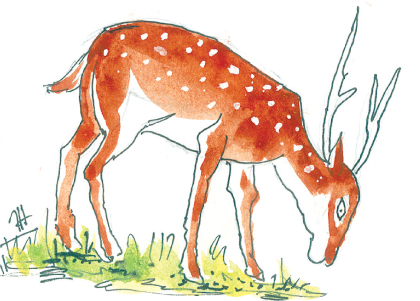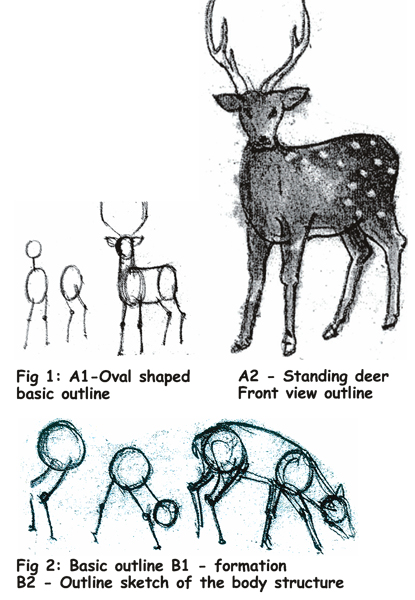|
[Learn to draw]
By Tissa Hewavitarane
Drawing and painting
deer
 There is no difference in painting a wild or domestic animal. It is
difficult to observe wild animals. Observation is the starting point and
more knowledge can be gained from photographs, visit to the zoo, museums
or by reading. The Deer is also an attractive animal which could be
easily drawn and painted. There is no difference in painting a wild or domestic animal. It is
difficult to observe wild animals. Observation is the starting point and
more knowledge can be gained from photographs, visit to the zoo, museums
or by reading. The Deer is also an attractive animal which could be
easily drawn and painted.
This animal can be easily spotted in parks, forests and the zoo. It
is difficult to paint directly from nature with wild life subjects.
Although it is better to draw and paint them while observing them as far
as possible, photographs and video films can be used.
Before painting you need to study the animal you intend to draw.
Information about their body structure, hair patterns, movements and
mainly the head need to be studied. The head is the most difficult part
to draw and paint.
Figure 1: The basic outline drawn as an oval shape on A1 and A2 which
shows the whole body structure of the standing deer with ears, antlers
and the front view. A3 shows a complete colour painting of the deer.

At first basic wash of burnt sienna is applied over the body. A pale
wash is applied as the first coating. When the face, ears, chest and the
legs are dry, use a No. 3 or 4 brush loaded with a clean mixture of a
little yellow ochre. To complete the painting a thin outline is drawn
with No. 1 brush or thin nibbed pen dipped in black ink.
Figure 2 - B1 shows the basic outline of a profile of a deer
approaching to eat. B2 an outline sketch of the shape of the body
structure, with the movement of legs. A pale wash of burnt sienna is
applied as the first coat and extra strong colour is put on with white
spots. Next the colour is strengthened and depened with a little burnt
sienna on the head, back and belly.
The hair is depicted using a fine brush No. 1. Notice the white spots
on the chest and belly which is painted with white, while a black
outline for the antlers are drawn and complete the painting.
The paper used is Kent or Whatman 180 gsm and brushes used Sable hair
No. 1 4 and 6. The final addition is green ranging from a pale yellowish
green depicting grass. |

